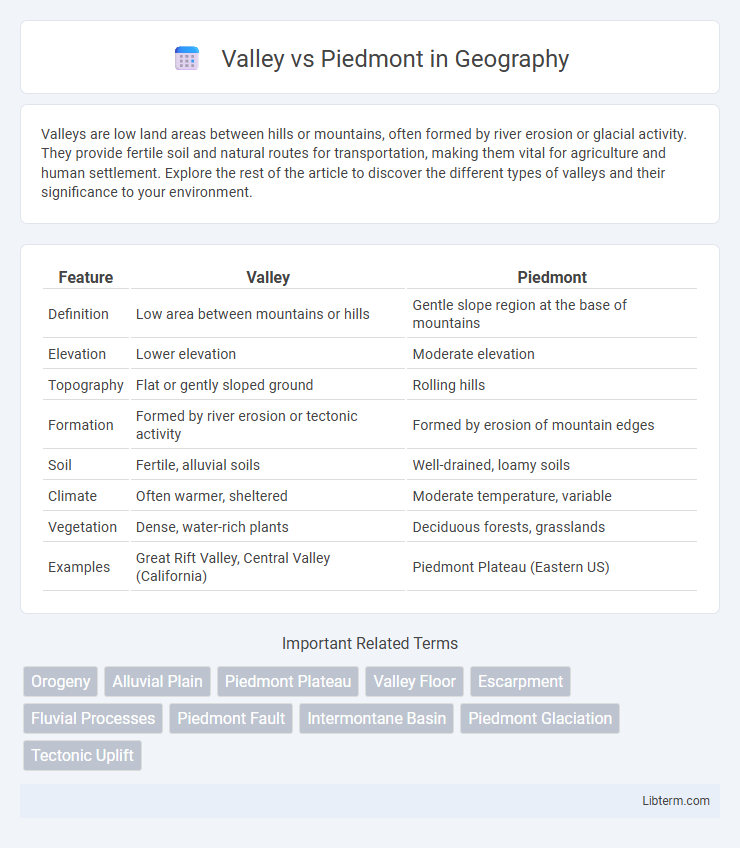Valleys are low land areas between hills or mountains, often formed by river erosion or glacial activity. They provide fertile soil and natural routes for transportation, making them vital for agriculture and human settlement. Explore the rest of the article to discover the different types of valleys and their significance to your environment.
Table of Comparison
| Feature | Valley | Piedmont |
|---|---|---|
| Definition | Low area between mountains or hills | Gentle slope region at the base of mountains |
| Elevation | Lower elevation | Moderate elevation |
| Topography | Flat or gently sloped ground | Rolling hills |
| Formation | Formed by river erosion or tectonic activity | Formed by erosion of mountain edges |
| Soil | Fertile, alluvial soils | Well-drained, loamy soils |
| Climate | Often warmer, sheltered | Moderate temperature, variable |
| Vegetation | Dense, water-rich plants | Deciduous forests, grasslands |
| Examples | Great Rift Valley, Central Valley (California) | Piedmont Plateau (Eastern US) |
Introduction to Valleys and Piedmonts
Valleys are low-lying landforms often formed by river erosion or glacial activity, characterized by elongated depressions between hills or mountains. Piedmont regions lie at the base of mountains, featuring gently sloping terrain that transitions from high elevations to flat plains. Both valleys and piedmonts play crucial roles in ecosystem diversity, agriculture, and human settlement patterns.
Defining Valleys: Key Characteristics
Valleys are elongated low areas typically found between mountains or hills, formed by erosion from rivers or glaciers. They often exhibit fertile soil and support diverse ecosystems due to sediment deposits and water availability. The defining characteristics of valleys include their V-shaped or U-shaped cross-sections and their role as natural channels for water flow.
Understanding Piedmonts: Essential Features
Piedmont regions are characterized by gently rolling hills that lie between coastal plains and mountainous areas, providing fertile soil ideal for agriculture. Their elevation ranges typically from 300 to 1,500 feet above sea level, promoting moderate climate conditions that support diverse vegetation and human settlement. Piedmont areas often serve as transitional zones, influencing local ecosystems and economic activities distinct from the surrounding valley or mountain regions.
Geographic Formation: Valley vs Piedmont
The Valley region is characterized by long, fertile river valleys flanked by mountain ridges formed through sediment deposition and tectonic folding during the Appalachian orogeny. In contrast, the Piedmont consists of rolling hills and gentle slopes created by the erosion of ancient crystalline metamorphic and igneous rocks uplifted during the same geological events. The Valley features alluvial soils ideal for agriculture, whereas the Piedmont showcases rocky terrain with mixed forest cover resulting from its resistant bedrock formations.
Climate Differences Between Valleys and Piedmonts
Valleys typically experience more temperature variation with colder winters and hotter summers due to cold air settling in low areas, while Piedmonts benefit from more moderate climates influenced by their elevated, rolling terrain. Valleys often have higher humidity and fog frequency because of limited air circulation and moisture accumulation, whereas Piedmonts enjoy better airflow and lower humidity levels. These climatic differences affect local agriculture, vegetation, and weather patterns unique to each geographic region.
Biodiversity: Flora and Fauna Comparison
The Valley region boasts diverse ecosystems with rich riparian habitats supporting unique species such as valley oak and tule elk, while the Piedmont features mixed hardwood forests and grasslands home to oak woodlands and black-tailed deer. Flora in the Valley is adapted to wetter, alluvial soils, including native willows and cottonwoods, contrasting with the Piedmont's drought-resistant chaparral and manzanita shrubs. Fauna diversity in the Valley includes species reliant on open wetlands and seasonal streams, whereas Piedmont's varied elevations provide niches for upland birds, reptiles, and endemic amphibians.
Human Settlement Patterns in Valleys vs Piedmonts
Human settlement patterns in valleys tend to be more concentrated due to fertile soil, abundant water resources, and natural protection from harsh weather. In contrast, piedmont regions generally exhibit dispersed settlements as the gently rolling terrain supports agriculture, transportation routes, and mixed land use. Valleys often develop dense urban centers along rivers, while piedmonts host suburban and rural communities spread across hillsides.
Economic Activities in Valleys and Piedmont Regions
Valley regions primarily support agriculture and horticulture due to their fertile soils and access to water resources, fostering the cultivation of crops such as rice, wheat, and vegetables. Piedmont areas, characterized by rolling hills and moderate elevation, promote mixed economic activities including viticulture, livestock farming, and mining of minerals like coal and iron ore. Industrial development and commerce are more prominent in Piedmont zones due to better transportation networks and proximity to urban centers.
Environmental Challenges: Valley vs Piedmont
The Valley region faces environmental challenges such as frequent flooding and soil erosion due to its low-lying terrain and extensive river systems. In contrast, the Piedmont struggles with urban sprawl and habitat fragmentation resulting from rapid development and deforestation on its rolling hills. Both regions must address water quality issues, but the Valley contends more with sedimentation, while the Piedmont deals with increased runoff and pollution from impervious surfaces.
Conclusion: Choosing Between Valley and Piedmont
Choosing between the Valley and Piedmont regions depends on factors such as climate preference, soil type, and agricultural needs. The Valley offers fertile soil and a milder climate suitable for crops like tobacco and vegetables, while the Piedmont's rolling hills and well-drained soil favor vineyards and orchards. Understanding these geographic and environmental differences helps optimize land use and agricultural productivity.
Valley Infographic

 libterm.com
libterm.com